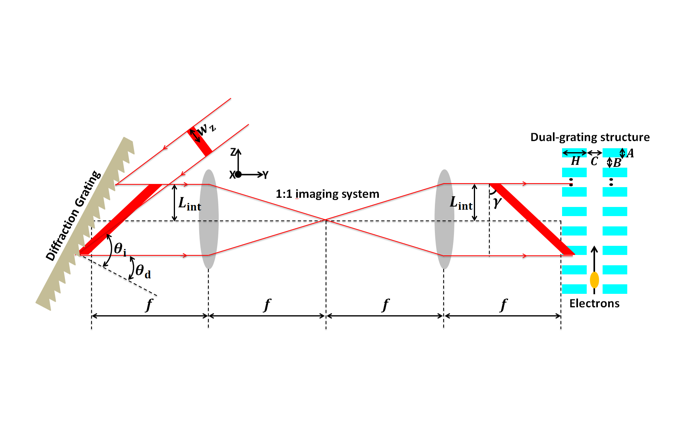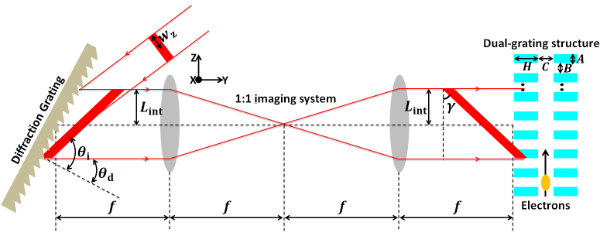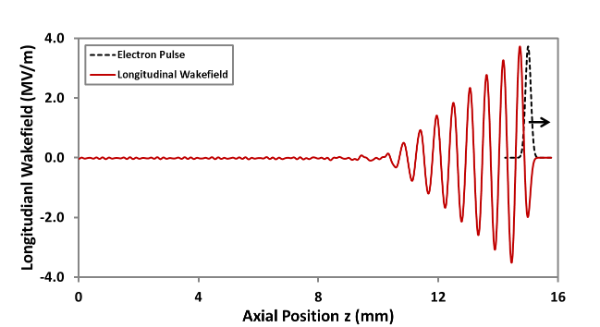Dielectric laser-driven accelerators as a novel concept for advanced accelerator research

Dielectric laser-driven accelerators (DLAs) have been demonstrated to accelerate electrons with an accelerating gradient of 690 ± 100 MeV/m. It opens the way to build a future particle accelerator “on a chip” much cheaper than a conventional one. However, previous DLA studies were performed with a normally-incident laser beam. In this case, the increase in electron energy is limited by the short interaction length between the laser pulses and the electron bunch.
In an open access paper just published in the “Applied Optics” journal, QUASAR member Yelong Wei and co-authors investigate numerically dual-grating dielectric laser-driven accelerators driven by a pulse-front-tilted (PFT) laser, which extends the interaction length and boosts the electrons’ energy gain. The optical system necessary to generate PFT laser beams with an ultrashort pulse duration of 100 fs is also studied in detail. Through two-dimensional (2D) particle-in-cell simulations, they show that such a PFT laser effectively increases the energy gain by (91 ± 25) % compared to that of a normally-incident laser with a waist radius of 50 μm for a 100-period dual-grating structure.

Diagram of a PFT laser generated by a dedicated optical system.
Moreover, it is also found that the energy gain is strongly dependent on the tilt angle, incident laser waist radius and the number of structure periods. The maximum energy gain occurs at a tilt angle of 𝛾 = 450 for relativistic electrons. For a 100-period dual-grating structure, when the incident laser waist radius wz increases from 50 µm to 500 µm, the energy gain gradually saturates to 110 ± 7 keV. For an incident laser with a waist radius of 1000 µm, a PFT laser beam with an interaction length of Lint = 1020 µm can be generated using our optical system. When such a PFT laser beam is introduced to illuminate a dual-grating structure with over 4000 periods, a maximum energy gain of 2.0 MeV can be expected.
In addition, Yelong Wei and co-authors also investigates dual-grating structures driven by THz pulses to accelerate electrons in the other open access paper just accepted in the “Nuclear Instruments and Methods A” journal. The wakefield effect which may result in bunch energy modulation in the dual-grating structures is studied in detail. When the bunch travels out of the structure, the average energy is reduced due to its interaction with longitudinal decelerating wakefield, as shown in figure 2. Then, an intense THz pulse is added into simulation to interact with the CLARA bunch in the optimized structure. The simulations show that an accelerating gradient of 348 ± 12 MV/m with an emittance growth of 3.0% can be obtained. These simulation studies will be validated by the further experimental studies using Swiss FEL with the collaborations of researchers from Paul Scherrer Institute, Switzerland.

Simulated longitudinal wakefield distribution on z-axis. The electron bunch travels along the z-axis.
To find out more please visit:
https://doi.org/10.1364/AO.56.008201
https://doi.org/10.1016/j.nima.2017.09.050
Y. Wei, et al., “Dual-grating dielectric accelerators driven by a pulse-front-tilted laser”, Applied Optics 56, 8201-8206 (2017).
Y. Wei, et al., “Investigations into dual-grating THz-driven accelerators”, Nuclear Instruments and Methods A, In Press, Accepted Manuscript (2017).